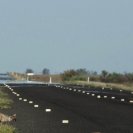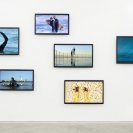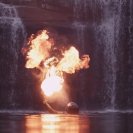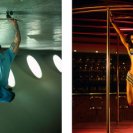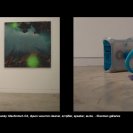The video work of Shaun Gladwell takes physical interaction as a starting point for the interplay between gesture and form. His video work since the late 1990s has utilised the medium to record performative action — dance, sport, skateboarding and biking —and sets this movement within video works that are artfully and aesthetically composed. The artist uses split frames, flipped camera angles, restricted fields of view or eerie slow motion, screened across split screens, projections and installations to explore the possibilities of video installation. Gladwell’s video is unrepentantly formalist in tone, and visually arresting.
Gladwell’s Loco Tapes (2004) presented a straightforward approach to the documentation of actions — simple, single frame video works that depict diary-style montages of people cycling, skateboarding and dancing, intercut with short dialogue and music scenes that present a context for the action. Gladwell’s simpler performance videos such as Storm Sequence (2000) and Tangara (2003) represent the rich visual style the artist has explored for the better part of a decade. Storm Sequence presents the artist executing balletic twirls on his skateboard in lashing rain set against ominous storm clouds at Bondi Beach. Tangara documents the artist hanging upside down in the entry way to a suburban commuter train, but with the camera turned upside down to create a disorienting spatial relationship. Both works are simple yet visually rich, using basic production methods to maximum effect.
Video works featuring bikes such as Double Line Work (2000), Hikaru: Fast Food Sequence (2001) and Busan Calligraphy + Slowburn (2006) create parallels between movement and the act of drawing. The metaphorical exploration of the visual trace of line made by movement captured on video and the mark left by painting and drawing — the white lines in the centre of a highway in Double Line Work for example — found literal expression in Busan Calligraphy which documents a rider exploring the acrobatic possibilities of a small bike in a gallery space filled with traditional Korean calligraphic drawings. Gladwell’s has repeatedly returned to his interest in dance/body movement in videos such as Woolloomooloo Night (2004), Pataphysical Man (Silent) (2005), and In A Station of The Metro (2006).
Many of Gladwell’s works have been presented in multiple-screen formats. A survey of his work presented at Artspace in Sydney in 2008 utilised a range of screens, from the small video display of PSP game machines to double screen projections thrown onto angled walls. Videos such as In A Station of The Metro — which features two figures on the floor of a ticket concourse in a Japanese subway station holding almost identical poses — deployed the double, angled images of two synchronised projectors to create a faux mirror image. This careful attention to the detail of presentation marks out Gladwell’s work and its aesthetic intentions.
Gladwell’s projects have evolved into increasingly complex pieces, presented in parts, or in installations across multiple screens intended to be taken as single works. His MADDESTMAXIMVS (2007) is an eight part work, including videos such as the double-screen Approach to Mundi Mundi (2007) to installations of the back-lit photographic work Contact Vanitas Scans (2007). Gladwell’s obsession with mirroring is again explored in Approach to Mundi Mundi which presents a two screen video of a motorbike on a stretch of barren road, the rider accompanied by a passenger who stands upright on the bike in the pose of a crucifix. The reflected gaze — the mirror and the double — are again found in Maximus as Narcissus: Broken Field of Reflection (2007), where a dirt bike rider encounters his reflection in a puddle.
The artist’s more recent videos such as Ghost Rider (2008) have, like his ambitious use of architectural form in his gallery exhibitions, sought to further extend the experience of the work into sculptural space. Ghost Rider was a single screen video of a rider pedaling a mountain bike through the deserted night of Sydney’s streets and underground expressways, jumping off the bike to let it “ghost” along sans rider. Together with the screen, the artist presented a series of mountain bikes on stands, their hollow metal constructions turned into ersatz musical instruments through the installation of tiny speakers, filling the gallery space with a ghost like whistling.
Selected solo exhibitions: Maddest Maximus, Sherman Galleries, Sydney, In a Station of the Metro, Artspace, Sydney, 2007. Shaun Gladwell, Hallwalls Contemporary Arts Centre, Buffalo, NY, 2006. Shaun Gladwell: Various Roles, Institute of Modern Art, Brisbane, Mmxbreakless Sessions, Sherman Galleries, Sydney, 2005. New Balance, Perth Institute of Contemporary Art (PICA), Perth, 2004.
Selected group exhibitions: Think with the senses, feel with the mind – art in the present tense, 52nd International Art Exhibition, La Biennale di Venezia, Italy,Space for Your Future, Museum of Contemporary Art, Tokyo, Japan. Living the City, Platform 21, Amsterdam, The Netherlands, SHIFT: festival for electronic arts, Shaulager, Basel, Switzerland, Southern Panoramas, 16th International Electronic Art Festival, VIDEOBRASIL, São Paulo, Brazil, Experimenta Playground, BlackBox, Arts Centre, Melbourne, Shaun Gladwell, Noorderzon Festival of Performing Arts, Groningen, The Netherlands, Bicycle Club, Kordegarda Gallery, Zacheta National Gallery, Warsaw, Poland, 2007.
Selected publications: Shaun Gladwell: Video Work, Artspace, Sydney, The Venice Biennale, all ‘Americana’, Art in America, September, 2007, An artist’s biennial, Frieze, September 2007, Hanging tough: Shaun Gladwell, Dazed, September 2007,








